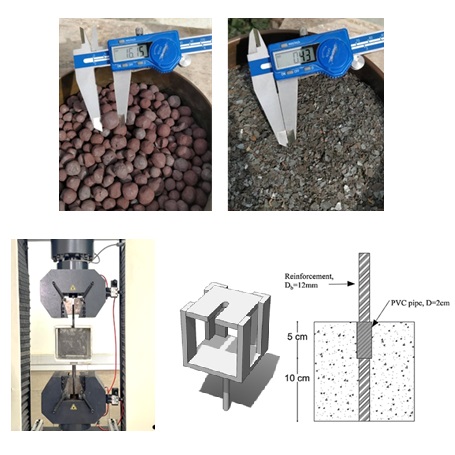The Evaluation of the bond strength of heavyweight concrete containing iron pellets
DOI:
https://doi.org/10.61186/7.3.69Keywords:
Heavyweight concrete, bond strength, iron pellets, pull out testAbstract
Heavyweight concrete incorporating iron aggregates is widely utilized as a radiation-shielding material in environments with harmful radiation due to its high density. Although this material is also employed as a structural component, certain mechanical properties, such as the bond strength between concrete and reinforcing steel bars, remain insufficiently studied. This paper investigates the bond strength of concrete containing varying percentages of iron pellets and its interaction with steel reinforcement. For this study, 25%, 75%, and 100% of the concrete aggregate was replaced with iron pellets, ensuring an appropriate grain size distribution. After curing under standard conditions, the specimens were subjected to direct pull-out tests. The results indicate that, except for the sample with 25% iron pellets, the inclusion of iron pellets slightly reduces compressive strength but enhances bond strength across all samples. Notably, adding 25% iron pellets combined with 5% micro silica in heavyweight concrete significantly improves compressive strength by 20% and bond strength by 43%.
References
[1] Zhou, K.-P., Yi, W.-J., Hwang, H.-J. and Zhou, Y., "Influence of bond test methods on the bond performance between reinforcing bars and concrete", in Structures, Elsevier. Vol. 54, No., (2023), 1299-1311. https://doi.org/10.1016/j.istruc.2023.05.083
[2] Syll, A.S. and Kanakubo, T., "Impact of corrosion on the bond strength between concrete and rebar: A systematic review", Materials, Vol. 15, No. 19, (2022), 7016. https://doi.org/10.3390/ma15197016
[3] Hosseini, S.A. and Etedali, S., "Laboratory evaluation of bond strength between rebar and concrete containing limestone powder", Amirkabir J Civ Eng, Vol. 52, No. 9, (2019), 10-10. https://doi.org/10.22060/ceej.2019.16315.6186
[4] Rao, G.A., Pandurangan, K., Sultana, F. and Eligehausen, R., "Studies on the pull-out strength of ribbed bars in high-strength concrete", Proc. of FraMCoS-6, Vol., No., (2007), 295-301
[5] Sonebi, M., Davidson, R. and Cleland, D., "Bond between reinforcement and concrete–influence of steel corrosion", in International conference on Durability of building Materials and Components, Porto–Portugal. Vol., No., (2011), 1-8
[6] Zhao, J., Luo, X., Wang, Z., Feng, S., Gong, X. and Shumuye, E.D., "Experimental study on bond performance of carbon-and glass-fiber reinforced polymer (cfrp/gfrp) bars and steel strands to concrete", Materials, Vol. 14, No. 5, (2021), 1268
[7] Hosseini, S.A. and Bagheri, M., "The effect of fly ash on the bond strength of steel reinforcement and concrete", Iranian Journal of Science and Technology, Transactions of Civil Engineering, Vol. 46, No. 1, (2022), 285-292. https://doi.org/10.1007/s40996-021-00617-8
[8] Ahmed, K., Siddiqi, Z., Ashraf, M. and Ghaffar, A., "Effect of rebar cover and development length on bond and slip in high strength concrete", Pakistan Journal of Engineering and Applied Sciences, Vol., No., (2008),
[9] Lin, R., Yu, X., Qin, C. and Ju, Y., "Study on the bonding performance between reactive powder concrete and steel bar", in Journal of Physics: Conference Series, IOP Publishing. Vol. 2368, No. 1, (2022), 012034
[10] Wang, D., Han, L., Ju, Y., Zeng, C. and Li, Z., "Bond behavior between reinforcing bar and reactive powder concrete", Structural Concrete, Vol. 23, No. 4, (2022), 2630-2642
[11] Rosyidah, A., Tjondro, J.A. and Sucita, I.K., "The bond strength of steel bar base on rib geometry bar in pullout test", Stavební obzor-Civil Engineering Journal, Vol. 30, No. 1, (2021),
[12] Burdziński, M. and Niedostatkiewicz, M., "Experimental-numerical analysis of the effect of bar diameter on bond in pull-out test", Buildings, Vol. 12, No. 9, (2022), 1392
[13] Hou, L., Sun, H., Liu, G., Huang, T. and Chen, D., "Bond strength of deformed reinforcement embedded in steel fiber reinforced concrete: Influencing factors and prediction model", Construction and Building Materials, Vol. 407, No., (2023), 133436
[14] Orangun, C., Jirsa, J. and Breen, J., "A reevaulation of test data on development length and splices", in Journal Proceedings. Vol. 74, No. 3, (1977), 114-122
[15] Darwin, D., McCabe, S.L., Idun, E.K. and Schoenekase, S.P., "Development length criteria: Bars not confined by transverse reinforcement", ACI structural Journal, Vol. 89, No., (1992), 709-709
[16] Hadi, M.N., "Bond of high strength concrete with high strength reinforcing steel", Vol., No., (2008),
[17] Esfahani, M.R. and Rangan, B.V., "Bond between normal strength and high-strength concrete (hsc) and reinforcing bars in splices in beams", Structural Journal, Vol. 95, No. 3, (1998), 272-280
[18] Diab, A.M., Elyamany, H.E., Hussein, M.A. and Al Ashy, H.M., "Bond behavior and assessment of design ultimate bond stress of normal and high strength concrete", Alexandria Engineering Journal, Vol. 53, No. 2, (2014), 355-371

Downloads
Published
Issue
Section
License
Copyright (c) 2025 Journal of Civil Engineering Researchers

This work is licensed under a Creative Commons Attribution 4.0 International License.




